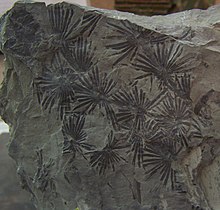
Ginkgoales is a gymnosperm order containing only one extant species: Ginkgo biloba, the ginkgo tree. It is monotypic, within the class Ginkgoopsida, which itself is monotypic within the division Ginkgophyta. The order includes five families, of which only Ginkgoaceae remains extant.
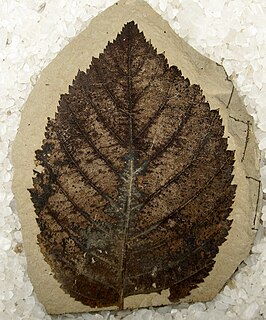
Paleobotany, which is also spelled as palaeobotany, is the branch of botany dealing with the recovery and identification of plant remains from geological contexts, and their use for the biological reconstruction of past environments (paleogeography), and the evolutionary history of plants, with a bearing upon the evolution of life in general. A synonym is paleophytology. It is a component of paleontology and paleobiology. The prefix palaeo- means "ancient, old", and is derived from the Greek adjective παλαιός, palaios. Paleobotany includes the study of terrestrial plant fossils, as well as the study of prehistoric marine photoautotrophs, such as photosynthetic algae, seaweeds or kelp. A closely related field is palynology, which is the study of fossilized and extant spores and pollen.
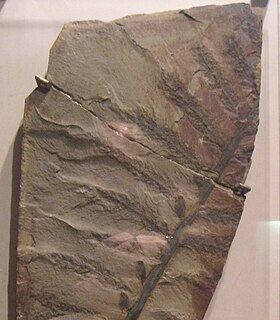
Archaeopteris is an extinct genus of progymnosperm tree with fern-like leaves. A useful index fossil, this tree is found in strata dating from the Upper Devonian to Lower Carboniferous, the oldest fossils being 385 million years old, and had global distribution.
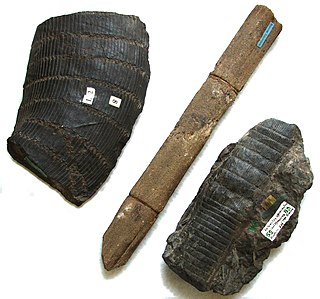
Calamites is a genus of extinct arborescent (tree-like) horsetails to which the modern horsetails are closely related. Unlike their herbaceous modern cousins, these plants were medium-sized trees, growing to heights of 30-50 meters. They were components of the understories of coal swamps of the Carboniferous Period.
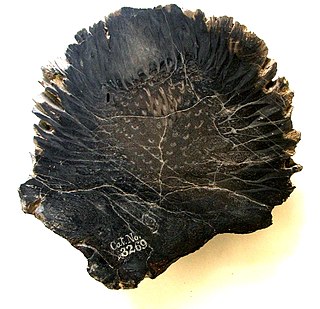
Bennettitales is an extinct order of seed plants that first appeared in the Permian period and became extinct in most areas toward the end of the Cretaceous. Bennettitales are among the most common Mesozoic seed plants, and had morphologies including shrub and cycad-like forms. The foliage of bennettitaleans is superficially nearly indistinguishable from that of cycads, but they are distinguished from cycads by their more complex flower-like reproductive organs, at least some of which were likely pollinated by insects.

Calamitaceae is an extinct family of plants related to the modern horsetails. Some members of this family attained tree-like stature during the Carboniferous Period and in Permian Period, reaching heights of up to 20 meters. The family takes its name from its principal genus Calamites.

The Mazon Creek fossil beds are a conservation lagerstätte found near Morris, in Grundy County, Illinois. The fossils are preserved in ironstone concretions, formed approximately 309 million years ago in the mid-Pennsylvanian epoch of the Carboniferous period. These concretions frequently preserve both hard and soft tissues of animal and plant materials, as well as many soft-bodied organisms that do not normally fossilize. The quality, quantity and diversity of fossils in the area, known since the mid-nineteenth century, make the Mazon Creek lagerstätte important to paleontologists, in attempting to reconstruct the paleoecology of the sites. The locality was declared a National Historic Landmark in 1997.

Sigillaria is a genus of extinct, spore-bearing, arborescent (tree-like) plants. It was a lycopodiophyte, and is related to the lycopsids, or club-mosses, but even more closely to quillworts, as was its associate Lepidodendron.
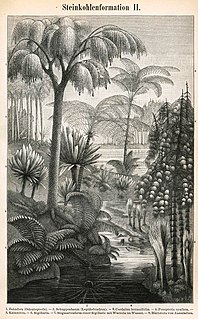
Coal forests were the vast swathes of wetlands that covered much of the Earth's tropical land areas during the late Carboniferous (Pennsylvanian) and Permian times. As vegetable matter from these forests decayed, enormous deposits of peat accumulated, which later changed into coal.
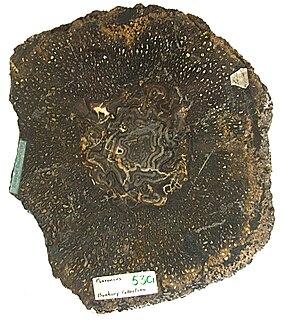
Psaronius was a Marattialean tree fern which grew to 10m in height, and is associated with leaves of the organ genus Pecopteris and other extinct tree ferns. Originally, Psaronius was a name for the petrified stems, but today the genus is used for the entire tree fern. Psaronius tree fern fossils are found from the Carboniferous through the Permian.

Nilssonia is a genus of fossil foliage traditionally assigned to the Cycadophyta either in Cycadales or their own order Nilssoniales, though the relationships of this genus with the Cycadales have been put into question on chemical grounds.

Macroneuropteris is a genus of Carboniferous seed plants in the order Medullosales. The genus is best known for the species Macroneuropteris scheuchzeri, a medium-size tree that was common throughout the late Carboniferous Euramerica. Three similar species, M. macrophylla, M. britannica and M. subauriculata are also included in the genus.
